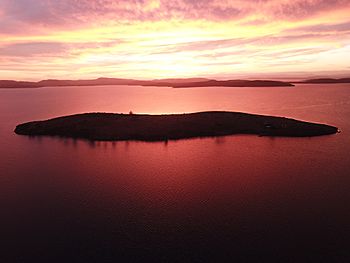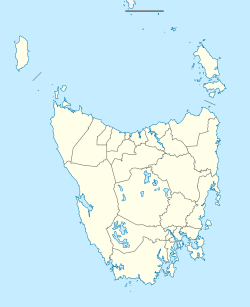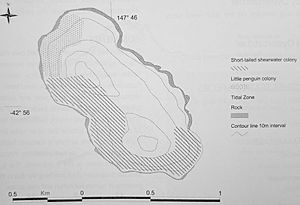Smooth Island (Tasmania) facts for kids

Smooth Island sunset
|
|
|
Location in Tasmania
|
|
| Geography | |
|---|---|
| Location | Norfolk Bay |
| Coordinates | 42°56′24″S 147°46′48″E / 42.94000°S 147.78000°E |
| Archipelago | Sloping Island Group |
| Area | 59.31 ha (146.6 acres) |
| Coastline | 3.38 km (2.1 mi) |
| Highest elevation | 44 m (144 ft) |
| Administration | |
| State | Tasmania |
| Additional information | |
| Time zone | |
Smooth Island is a private island located off the southeastern coast of Tasmania, Australia. It covers an area of about 59.31 hectares (146.6 acres). The island is part of the Sloping Island Group in Norfolk Bay, surrounded by the Tasman and Forestier Peninsulas. Nearby towns include Dunalley and Murdunna. Smooth Island is special because it is one of the few islands in Tasmania that is fully owned by its private owners, right down to the high-water mark.
Contents
About Smooth Island
Smooth Island is managed by the Tasman Council. It is part of the Pembroke land district and is included in the Rumney legislative council area. For state and federal elections, it falls within the electorate of Lyons. The island is also part of the 'East Coast' Fire Management Area.
Smooth Island is privately owned, meaning it has a full freehold title with no special rules or agreements attached to its ownership. In 2014, Smooth Island was officially named a Private Forest Timber Reserve. The ocean area 200 meters (656 feet) from the island's coastline is protected as an Environmental Management Zone under the Tasman Interim Planning Scheme of 2015.
Visiting Smooth Island
Smooth Island is private property, and this includes the coastline up to the high-water mark. Because of this, public access is not allowed without permission. This also means boats cannot moor there without permission. If you have permission, the island is easy to reach by boat or helicopter. The land on the island is suitable for building a small airstrip.
Island Services
The island gets radio signals from ABC Local Radio (936 AM). It also has 3G mobile phone service from Telstra and wireless internet from the National Broadband Network. The table below shows how close important services and facilities are to Smooth Island.
| Service type | Name | Address | Coordinates | Distance by air | Distance by boat | Distance by road from Murdunna | Reference |
|---|---|---|---|---|---|---|---|
| Public boat ramp | Murdunna boat ramp | 5.7 km | 5.8 km | – | |||
| Ambulance | Dodges Ferry Ambulance Station | 17 km | 21 km | 28 km | |||
| Medical (family doctor) | Dodges Ferry Medical | 17 km | 21 km | 28 km | |||
| Major hospital | Royal Hobart Hospital | 37.5 km | 56 km | 65 km | |||
| Police (and defibrillator) | Dunalley Police Station | 6.7 km | 6.7 km | 9 km | |||
| Mobile phone transmission tower | Telstra 3G 850 MHz | 6 km | – | – | |||
| Wireless internet transmission tower | National Broadband Network | 6 km | – | – | |||
| Fuel | Shell Dunalley | 6.5 km | 6.5 km | 9 km | |||
| General store | Dunalley Supermarket | 6.7 km | 6.7 km | 9 km | |||
| Large shopping centre | Sorell plaza shopping centre | 25 km | 29 km | 40 km |
Fishing Rules
The waters 200 meters (656 feet) out from the low water mark around Smooth Island are a Shark Refuge Area. This means you cannot catch sharks, skates, or rays there, except for elephantfish. If allowed, certain nets (graball nets) can only be used for a maximum of 2 hours, from sunrise until one hour before sunset. Mullet nets and set lines (long lines and drop lines) are not allowed.
Island Geography
Smooth Island is about 2.24 kilometers (1.39 miles) from both Dunbabin Point and Chronicle Point on the mainland. It is also about 2.3 kilometers (1.4 miles) from King George Island.
The island has two main hills with a lower area, called a saddle, between them. The North peak is 43 meters (141 feet) above sea level, the South peak is 40 meters (131 feet), and the saddle is 30 meters (98 feet) high.
Island Climate
Smooth Island has an oceanic climate, which means it has mild temperatures and rainfall throughout the year. This is similar to the climate at Hobart International Airport, which is about 26 kilometers (16 miles) from the island.
| Climate data for Hobart International Airport (26 km (16 mi) from Smooth Island) | |||||||||||||
|---|---|---|---|---|---|---|---|---|---|---|---|---|---|
| Month | Jan | Feb | Mar | Apr | May | Jun | Jul | Aug | Sep | Oct | Nov | Dec | Year |
| Mean daily maximum °C (°F) | 22.6 (72.7) |
22.3 (72.1) |
20.8 (69.4) |
18.1 (64.6) |
15.3 (59.5) |
12.9 (55.2) |
12.5 (54.5) |
13.5 (56.3) |
15.4 (59.7) |
17.3 (63.1) |
19 (66) |
20.7 (69.3) |
17.5 (63.5) |
| Mean daily minimum °C (°F) | 12 (54) |
12.1 (53.8) |
10.8 (51.4) |
8.8 (47.8) |
6.6 (43.9) |
4.6 (40.3) |
4.1 (39.4) |
4.7 (40.5) |
6.1 (43.0) |
7.5 (45.5) |
9.2 (48.6) |
10.8 (51.4) |
8.1 (46.6) |
| Average precipitation mm (inches) | 40.8 (1.61) |
35.9 (1.41) |
36.1 (1.42) |
42.2 (1.66) |
35.6 (1.40) |
32.5 (1.28) |
43.8 (1.72) |
47.1 (1.85) |
41.6 (1.64) |
46.3 (1.82) |
44.9 (1.77) |
52.6 (2.07) |
499.4 (19.65) |
| Source: Australian Bureau of Meteorology (1958–2015) | |||||||||||||
Island Ecosystem
Many different animals and plants have been seen on Smooth Island. Here is a list of some of them:
| List of species | |||||||||||||||||||||||||||||||||||||||||||||||||||||||||||||||||||||||||||||||||||||||||||||||||||||||||||||||||||||||||||||||||||||||||||||||||||||||||||||||||||||||||||||||||||||||||||||||||||||||||||||||||||||||||||||||||||||||||||||||||||||||||||||||||||||||||||||||||||||||||||||||||||||||||||||||||||||||||||||||||||||||||||||||||||||||||||||||||||||||||||||||||
|---|---|---|---|---|---|---|---|---|---|---|---|---|---|---|---|---|---|---|---|---|---|---|---|---|---|---|---|---|---|---|---|---|---|---|---|---|---|---|---|---|---|---|---|---|---|---|---|---|---|---|---|---|---|---|---|---|---|---|---|---|---|---|---|---|---|---|---|---|---|---|---|---|---|---|---|---|---|---|---|---|---|---|---|---|---|---|---|---|---|---|---|---|---|---|---|---|---|---|---|---|---|---|---|---|---|---|---|---|---|---|---|---|---|---|---|---|---|---|---|---|---|---|---|---|---|---|---|---|---|---|---|---|---|---|---|---|---|---|---|---|---|---|---|---|---|---|---|---|---|---|---|---|---|---|---|---|---|---|---|---|---|---|---|---|---|---|---|---|---|---|---|---|---|---|---|---|---|---|---|---|---|---|---|---|---|---|---|---|---|---|---|---|---|---|---|---|---|---|---|---|---|---|---|---|---|---|---|---|---|---|---|---|---|---|---|---|---|---|---|---|---|---|---|---|---|---|---|---|---|---|---|---|---|---|---|---|---|---|---|---|---|---|---|---|---|---|---|---|---|---|---|---|---|---|---|---|---|---|---|---|---|---|---|---|---|---|---|---|---|---|---|---|---|---|---|---|---|---|---|---|---|---|---|---|---|---|---|---|---|---|---|---|---|---|---|---|---|---|---|---|---|---|---|---|---|---|---|---|---|---|---|---|---|---|---|---|---|---|---|---|---|---|---|---|---|---|---|---|---|---|---|---|---|---|---|---|---|---|---|---|---|---|---|---|---|---|---|---|---|---|---|---|---|---|---|---|---|---|---|---|---|---|---|---|---|---|---|---|---|
|
Island Geology
Smooth Island is mostly made of a type of rock called diabase or dolerite. This rock formed from molten rock that pushed up into older rocks a very long time ago, likely during the Eocene epoch of the Cenozoic era.
A geological study found brownish, fine-grained sandstone on the island's northeast coast, about 2 meters (6.6 feet) above sea level. This sandstone was covered by sand. It was similar to sandstone found in South Arm that had many fossils, but no fossils were found in the Smooth Island samples. The western side of the island has dolerite rock with some granophyre from the Jurassic period. The underground water on the island is in a type of soil that can hold water, called a surficial sediment aquifer.
Because the island mostly has a rocky, sloping shoreline, it is not very likely to flood or erode if sea levels rise. A test for acid sulfate soil along the north and northeast sides of the island showed "extremely low" levels, which is good for the environment.
Marine Life Around the Island
Smooth Island is surrounded by a low reef. On the eastern coast, an area of gravel or "hard sand" stretches from the reef towards King George Island. The reef on the western coast is surrounded by sand, and a silty area is near the island's southwest coast.
Between Smooth Island and King George Island, there is a thick bed of seagrass (Halophila australis) and eelgrass (Zostera tasmanica), covering about 12.5 hectares (31 acres). Studies have shown many South Australian cobbler (Gymnapistes marmoratus) fish live here because they like patchy eelgrass beds. The east coast of the island has the most Little weed whiting (Neoodax balteatus) in Norfolk Bay. A study in 1995–1996 found that 88% of the fish caught were Little Rock Whiting (Neoodax balteatus) and Bridled Leatherjacket (Acanthaluteres spilomelanurus).
A type of red algae (Rhabdonia verticillata) has been found near the island. You can find fish like flathead, trumpeter, perch, cod, and Australian salmon in the waters around the island. Dolphins are often seen, and killer whales (Orcinus orca) are sometimes spotted nearby. The Spotted handfish and the Live-bearing Seastar (Parvulastra vivipara) are endangered marine species that might live in the waters around Smooth Island. A killer whale was seen 1 kilometer (0.62 miles) northeast of the lighthouse. Several humpback whales were also seen near Smooth Island in June 2017.
Restoring the Island's Nature
The land ecosystem of Smooth Island has been harmed by too much grazing by animals and by slashing and burning practices. Commercial hunting of wildlife also caused damage. Much of the island's natural plants have been replaced by non-native grasses, thistles, bracken, scattered eucalypt trees, and African boxthorn bushes.
Between 0.86 hectares (2.1 acres) and 18 hectares (44 acres) of shearwater bird nesting areas are on Smooth Island. The effect of repeated fires on these habitats has been studied. The current owners of the island plan to carefully restore its native ecosystem. Since March 2014, many different native Tasmanian plants have been planted across the island. Since grazing has stopped, eucalypt trees that are still there are also expected to spread their seeds on the island's southeast coast.
Island History
Island Names
Matthew Flinders found Smooth Island on December 15, 1798. He named it "Smooth Island" on his maps from that time, but it doesn't appear on his 1814 map. In 1824, Thomas Scott called the island "Garden Island" on his maps. The reasons for these different names are not fully clear. Other sources say the island was first named on maps by "Cross (1830)" and "Frankland (1837)", but then later state it was first called "Smooth Island."
A newspaper article from 1911 mentioned that the island "is not named in the map of D'Entrecasteaux, even though it was marked." In the early 2000s, Smooth Island was sometimes listed as "Lot 1 Norfolk Bay, Dunalley TAS 7177" in real estate ads.
There has been a lot of confusion about the names of many islands in Southeast Tasmania. "Garden Island" has been used as another name for both Green Island and Smooth Island. An old newspaper article from 1836 mentions a Garden Island in the Pembroke Land District.
Old Structures
A survey of Smooth Island was done on July 14, 1863. It showed where the original jetty (a pier for boats), a natural spring, and a guano (bird droppings used as fertilizer) digging site were on the island. Until 2014, there was a lighthouse on Smooth Island with the international marker K 3621.2. Marine and Safety Tasmania moved it after the island's owners asked them to.
Possible Uses for the Island
The south and west coasts of Smooth Island have alkaline soil, while the east slope has acidic soil. The crops that could grow best on the island include:
- Table wine grapes
- Sparkling wine grapes
- Industrial hemp
- Pyrethrum
- Blueberries
Phosphate mining was also considered. On October 13, 1941, people looked into whether mining phosphate on Smooth Island would be worth it, but they decided it was not.
Island Artwork
Smooth Island has been featured in two well-known paintings: Michael Weitnauer's Norfolk Bay and Dale Frank's "Dunalley, Smooth Island." It has also been mentioned in poems, such as "Two Kinds of Silence" by Kathryn Lomer:
I could lose or find myself
in this private Bermuda triangle-
Connelly's Bay, Lime Bay, Smooth Island;
In the dusk Smooth Island's navigation light
begins to blink its code name
to sailors bound for Dunalley
Images for kids




























